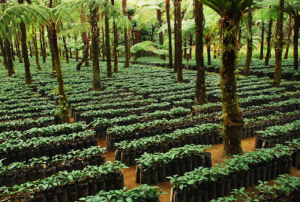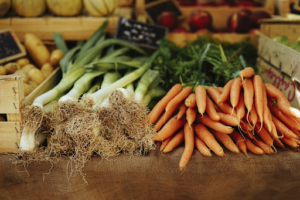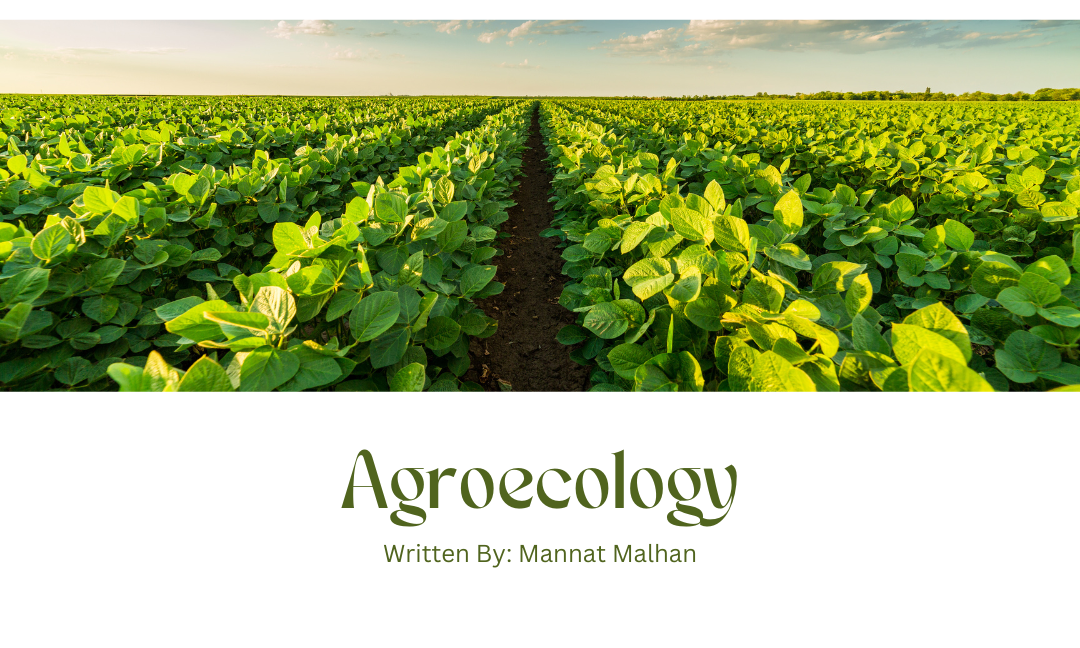Written By: Mannat Malhan
Edited By: Nehaa Kousihan
Designed By: Eshika Hiremath
Published By: Tvisha Lakhani
When you sit down to eat dinner, have you ever thought about how the delicious food got on your plate? Agroecology is the answer to that question! It’s the concept that explores how to sustainably produce food. In this blog, we’ll be diving deeper into the role of agroecology, look at some real life situations, and look at the adversities faced by amazing agro ecologists as they define agroecology through their eyes.

What is Agroecology?
First, let’s give a basic definition to agroecology. Agroecology is sustainable farming that works with nature. Knowing that ecology is the connections between animals, plants, and their environment, agroecology is the real life application of these concepts, along with farming. It is known to be the foundation of sustainable agriculture.
Why is Sustainable Food Production Important?
Sustainable food production is extremely important. It is a way of producing food without any pollution and conserving non-renewable energy and natural resources. Pretty awesome, right? Developing agroecological farming techniques helps make soil more fertile, minimise use of chemicals and boost crop diversity. Growing more than one crop in an area can help scientists develop new varieties that consumers want to eat. Crop diversification also needs to be adaptable to new, more resilient environments, and adapted to locals’ preferences.
Agroecological Principles
 There are many that make the foundation; diversity, synergies, knowledge sharing, efficiency, social values, and recycling.
There are many that make the foundation; diversity, synergies, knowledge sharing, efficiency, social values, and recycling.
Diversity is one of the ensuring ways to have food security and nutrition while protecting natural resources. It is seen the most throughout all of the principals, as seen below.
By having synergistic relations, many key ideas with food systems support sustainability and ecosystem care. Sharing knowledge throughout the processes of individuals helps create one final, efficient product. Efficiency is a key part, since agroecology nurtures the use of creative ideas which helps produce more and limit the use of unsafe resources. The science of agroecological techniques lies in the social concepts that help us furthermore discover more about it. It provides equity, equality, and well-being of people, securing livelihoods of many people. Moving on to recycling, which is familiar to most of us. Recycling in agriculture opens doors for lower economic and environmental costs. Products can be reused with less negative impact on the environment. Not only that, we learn how to value things we once thought were useless.
Benefits of Agroecology
Agroecology and its techniques are meant to be multifunctional, meaning to have purpose in various places, rather than just one. It combines Indigenous and scientific practices, and social concepts, along with ecology. Agroecological approaches on farming increase health, nutrition and ecological resilience, and biodiversity. All of these factors eventually lead to a more economically stable environment, as expected. Agroecology will help decrease the negative impacts of climate change, since it reduces the dependency farming has on fossil fuels such as coal, oil, and natural gas. Agroecological ways promote farmers’ well-being too, by prioritising local supply chains! The field of study rarely has short-term benefits and has almost no short term goals. Everything done in agroecology benefits today, and many other generations to come.
Examples of Agroecological Practices
There’s a lot under this topic but we’ll only be talking about three; Permaculture, home gardens, and traditional shade coffee. Yes, they are weird examples, but listen.
Permaculture is a philosophy for sustainability in life. Bill Mollison and David Holmgreen made the term in 1978, taking the word permanent and agriculture to create permaculture, a system of ecological farming. In their natural habitat, ecosystems live on their own and permaculture is a way of working with nature instead of against it. Examples of permaculture are managing waste or mitigating deforestation.
Home gardens are something we are all familiar with. They are just you in your backyard or somewhere else caring for plants. As you grow various items in your garden, you build an ecosystem. With the worms, birds, sun, water, soil, sky, bugs, or anything that’s supporting your garden. Even you count as one of the components working together. Home gardens are an amazing example of agroecological practices for many reasons. It produces food items that help in reducing hunger, malnutrition and improve food security. Along with educating new generations on food, it shows the complex relationship the garden has with the environment.
 Shade grown coffee is a crop produced from coffee plants grown under a canopy of trees, which provide shade from the sun. Traditionally, coffee is grown like this and provides many benefits. Shade-coffee causes the reduction of soil erosion. The roots of the canopy trees’ roots minimise the erosion caused by heavy rainfall. The leaves also give the soil nutrients and another pro for the environment is providing pollination plus habitats for invertebrates. Shade-grown coffee allows us to work with the environment to make coffee, and not cut down trees. Nice, right? Not only that, it’s great for your taste buds too! Many say that coffee grown under shade tastes appreciatively better than other coffees.
Shade grown coffee is a crop produced from coffee plants grown under a canopy of trees, which provide shade from the sun. Traditionally, coffee is grown like this and provides many benefits. Shade-coffee causes the reduction of soil erosion. The roots of the canopy trees’ roots minimise the erosion caused by heavy rainfall. The leaves also give the soil nutrients and another pro for the environment is providing pollination plus habitats for invertebrates. Shade-grown coffee allows us to work with the environment to make coffee, and not cut down trees. Nice, right? Not only that, it’s great for your taste buds too! Many say that coffee grown under shade tastes appreciatively better than other coffees.
Adversities Faced By Agroecologists + What You Can Do
The number one problem that affects everyone is climate change. It causes extreme weather, drought, and excessive rainfall, causing problems for the farmers. There is a high uncertainty with agroecological practices, especially right now, since agroecology is not a scalable practice that matches the output of agriculture.
Now, what steps can you take to help? Well, you can start right away! One thing you can do is save water, which saves your money and diverts less water from any source (lake, rivers, bays). You can also go online and look at various agroecology websites to see what’s going on. You may be able to donate and help with some issues too. Another thing, as mentioned above, is to start your own garden. It provides many nutrients to you and the environment around you.
So next time you think about the vegetables on your plate, maybe you won’t just see the fresh colours, but whatever happened to bring it there to you.
Sources
“What Is Agroecology?” Agroecology Fund, www.agroecologyfund.org/what-is-agroecology. Accessed 6 Dec. 2023.
Agroecology Fund, www.agroecologyfund.org/. Accessed 6 Dec. 2023.
“What is Permaculture? And How to Apply it to Your Garden” Nature’s Path, https://naturespath.com/en-ca/blogs/posts/what-is-permaculture, August 2018.
“What is Shade Grown Coffee, and Why Does it Matter?” Peak State, Danny Walsh, https://peakstatecoffee.com/en-ca/blogs/peak-state/what-is-shade-grown-coffee.
“Contribution of Home Gardens to Sustainable Development: Perspectives from a Supported Opinion Essay.” International Journal of Environmental Research and Public Health, Santos, Mário, vol. 19, no. 20, https://www.ncbi.nlm.nih.gov/pmc/articles/PMC9603381/, 21 Oct. 2022.
“THE 10 ELEMENTS of AGROECOLOGY GUIDING the TRANSITION to SUSTAINABLE FOOD and AGRICULTURAL SYSTEMS”, Food and Agriculture Organization of the United Nations, https://www.fao.org/3/i9037en/i9037en.pdf.
“Grand Challenges of Agroecology and Land Use Systems” Frontiers, P.K Ramachandran Nair, https://www.frontiersin.org/articles/10.3389/fenvs.2014.00001/full, January, 28, 2014.
“Agroecology; Benefits, Principles, Levels”, Environment Buddy, https://www.environmentbuddy.com/farming/agroecology-benefits-principles-levels-and-examples/.
Harvard T.H. Chan. “Sustainability.” The Nutrition Source, 17 Jan. 2019, www.hsph.harvard.edu/nutritionsource/sustainability/.

